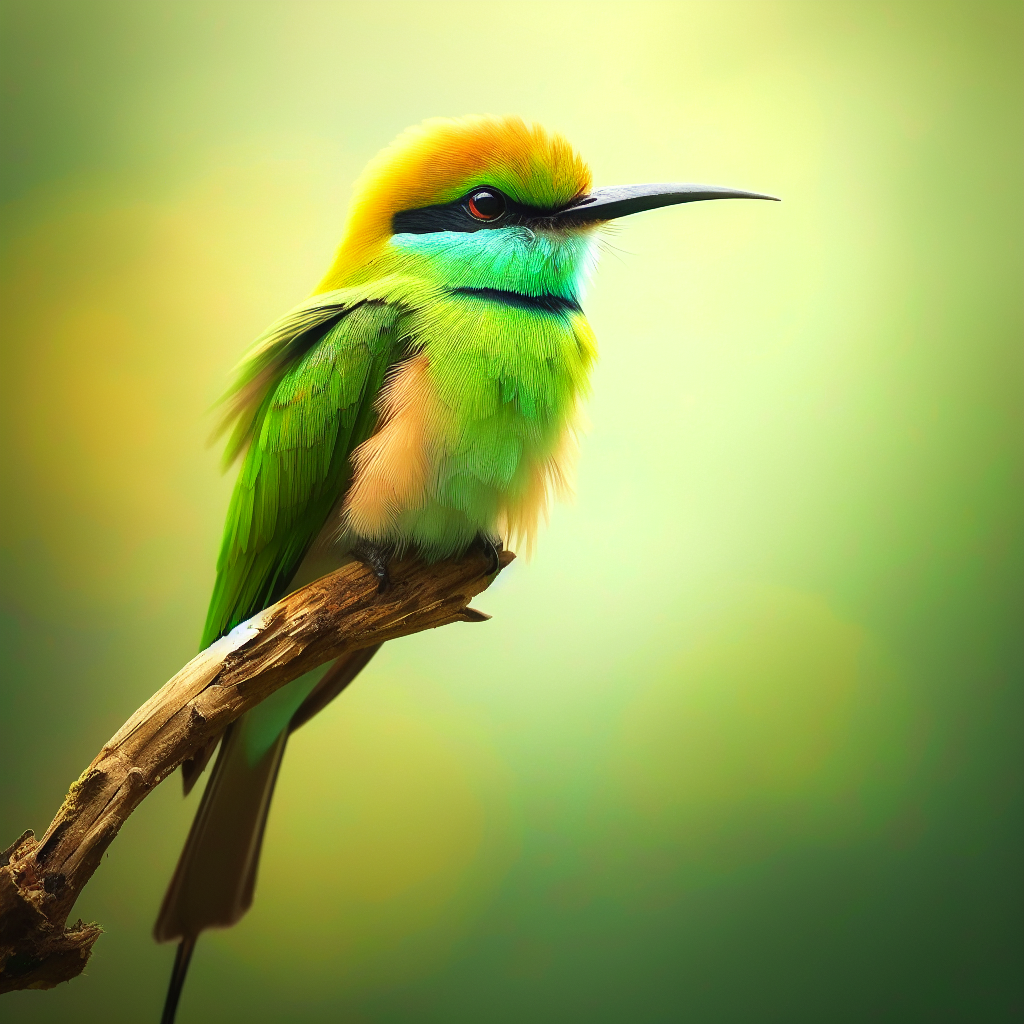Most beautiful small birds - Sykalo Eugen 2024
Asian Green Bee-eater (Merops orientalis)
Identification:
- Species name: Asian Green Bee-eater
- Scientific name: Merops orientalis
- Family: Meropidae (Bee-eaters)
- Order: Coraciiformes (Roller-like birds)
- Subclass: Neornithes (Modern birds)
- Class: Aves (Birds)
Description:
- Size: Small bird, about 9 inches (230 mm) long with about 2 inches (51 mm) of the total length comprised of elongated central tail feathers.
- Body shape: Slender and graceful, with a short neck, a long, straight beak, and a long, forked tail.
- Plumage color:
Males: Dazzlingly bright emerald green back and wings, iridescent turquoise throat, black eye mask and breastband, orange-rufous crown and nape, pale yellow underparts.
Females: Duller green upperparts, less distinct eye mask and breastband, and yellowish-green throat.
Black legs.
Dark eyes.
- Beak: Long, straight, and black, well-suited for catching insects in mid-air.
Behavior:
- Method of feeding: Primarily insectivorous, hunting by perching on a high vantage point and swooping down to catch bees, wasps, dragonflies, and other flying insects in mid-air.
- Reproduction: Builds nest tunnels in sandy banks or cliffs. Lays 4-7 glossy white eggs. Both parents care for the young.
- Movement: Migratory in most of its range, breeding in northern Asia and wintering in southern Asia and Southeast Asia.
- Communication: Loud and varied calls, including whistles, twitters, and chattering. Males have a complex song for defending territory and attracting mates.
Ecology:
- Habitat: Open woodlands, farmland, grasslands, riverbanks, and cliffs.
- Diet: Bees, wasps, dragonflies, grasshoppers, other flying insects.
- Hunting methods: Perches on exposed branches or twigs, then darts out to catch insects in mid-air with its long beak. May also hover briefly before swooping.
Distribution: Found across Asia, from coastal southern Iran east through the Indian subcontinent to Vietnam. Winters in southern Asia and Southeast Asia.

The Asian Green Bee-eater, an emerald jewel flitting through grasslands and scrublands of Asia, might seem like a simple insectivore at first glance. But beneath its vibrant green plumage and swift dives lies a treasure trove of fascinating facts and adaptations that will leave you captivated by this avian acrobat and aerial predator.
Masters of the Plunge: Forget dainty pecking; the Asian Green Bee-eater is a dive bombing champion. They plunge headlong into swarms of insects at breakneck speed, their long bills snapping with precision to catch their buzzing prey. Imagine them as feathered fighter jets with built-in miniature nets!
Hidden Feasting Technique: Their beaks aren't just for catching bees. Asian Green Bee-eaters have specially adapted beaks for crushing and removing the stingers of their captured insects before swallowing them. Talk about feathered chefs with built-in miniature deboning tools!
Unexpected Cooperative Breeders: While not as common as in other species, Asian Green Bee-eaters sometimes engage in cooperative breeding. Helpers, often older offspring or non-breeding individuals, assist the breeding pair in raising chicks, providing extra food and protection. It's a feathered commune with built-in childcare!
Communal Dust Bathers: Forget solitary primping; these bee-eaters are big on group dust baths. Up to 20 individuals gather in clearings, tossing dust onto their feathers with surprising enthusiasm. This helps remove parasites and keep their plumage in top condition — talk about feathered spa sessions with built-in communal saunas!
Hidden Vocal Mimicry: Don't underestimate their vocal talents! While not as skilled as some, Asian Green Bee-eaters have been known to mimic the calls of other birds, adding an unexpected twist to their repertoire. Imagine them as feathered DJs with built-in sound effect libraries!
Symbiotic Symphony: Asian Green Bee-eaters play a vital role in the ecosystem. By controlling insect populations, they help maintain the health of grasslands and scrublands, contributing to a balanced natural symphony. These feathered pest controllers contribute to the flourishing of plants and other creatures.
Cultural Charmers: In some Asian cultures, the Green Bee-eater is associated with good luck, prosperity, and the beauty of nature. Its vibrant plumage and graceful flight inspire awe and respect, making it a treasured symbol of the region's diverse ecosystems.
Unexpected Regional Variations: Did you know? Not all Green Bee-eaters are emerald green! Depending on their geographical location, some populations boast subtle variations in plumage color, adding a touch of diversity to this avian jewel across Asia.